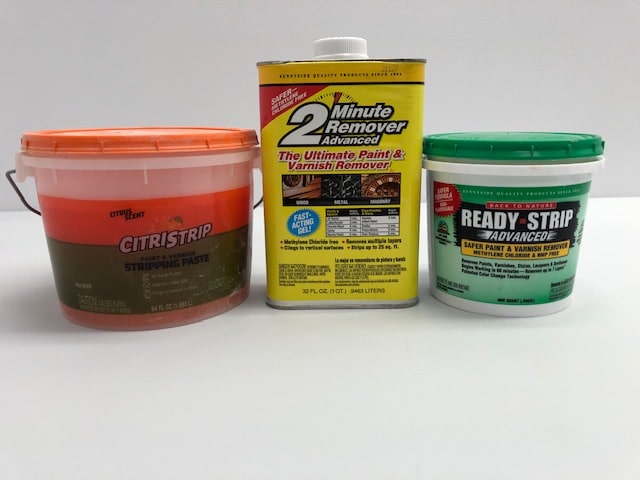I have wanted to test paint strippers for some time and we just had a situation where we could put different strippers to the test.
We had a cabinet door that needed to be stripped and decided to try three different products. We followed the directions on the label for each one. Both the primer and paint we were stripping were water based products and less then a week old.
Specifically we were removing one coat of INSL-X Stix, four coats of Buildermax primer and two coats of Breakthrough finish coat from a pine cabinet door.

- Citristrip About $12.00 a quart. Considered a “safe” stripper. It doesn’t have an offensive odor. Nothing was felt when we did a skin test. It had no impact on the paint in the time frame suggested.
- Readystrip $11.40 a quart or so. Also considered a “safe stripper. It has a distinct odor. Not too bad. Could feel it on our skin after about 30 sec. Almost no effect on the coating in the suggested time frame.
- 2 Minute Remover $9.00 a quart. Strong odor. Could feel it on skin almost immediately. Made short work of the coatings on the cabinet door. Good Stripper!
It is always a good idea to wear gloves and eye protection when using any paint stripper. I also suggest using the stripper in a well ventilated area and have rags and a way to wash up readily available.
The other two strippers, citristrip and readystrip may have worked over a longer time frame and may be a good way to go if speed of removal is not a factor.
After using any stripper it is important to neutralize and clean the surface after removing the paint. We use baking soda and clean up with Simple Green cleaner. Simple Green is a great product to have on hand. We also use it to neutralize concrete floors when we use acid to etch them.
Here are some additional safety precautions
While paint strippers can be very effective at removing coatings, they can also be dangerous to use if proper safety precautions are not followed. here are some additional safety precautions to keep in mind when using paint strippers.
Before using a paint stripper, it is important to test a small, inconspicuous area to ensure that the product will not damage the surface being stripped. It is also a good idea to test the product on a scrap piece of wood or metal to make sure it works as expected and to determine the appropriate application time.
When applying paint stripper, it is important to use it sparingly and only on the areas that need to be stripped. Avoid getting the product on your skin or clothing, and be sure to wash your hands thoroughly after use. If you do get the product on your skin, wash the affected area immediately with soap and water. If you get the product in your eyes, flush them with water and seek medical attention immediately.
It is also important to store paint strippers in a safe and secure location, out of the reach of children and pets. Dispose of paint stripper according to the manufacturer’s instructions and local regulations. Do not pour it down the drain or dispose of it in the trash unless specifically directed to do so by the manufacturer. This may include placing it in a special disposal container or taking it to a hazardous waste facility.
Choose the right product: There are many different types of paint strippers available, including those that work on specific types of coatings or surfaces. Be sure to select a product that is suitable for the job you are doing, and follow the manufacturer’s recommendations for use.
Wear protective clothing: In addition to gloves and goggles, it is a good idea to wear protective clothing, such as a long-sleeved shirt, pants, and closed-toe shoes, to avoid skin contact with the paint stripper.
Use caution with heat sources: Some paint strippers contain flammable solvents that can ignite if they come into contact with heat sources, such as cigarettes or open flames. Be sure to keep heat sources away from the area where you are using paint stripper, and do not smoke while using the product.
Consider alternative methods: If you are concerned about the safety of using paint strippers, you may want to consider alternative methods for removing paint, such as sanding or using a heat gun. These methods may take longer and may not be suitable for all types of surfaces or coatings, but they can be safer and more environmentally friendly.
By following these additional safety tips, you can help ensure that your paint stripping project is completed safely and effectively.


